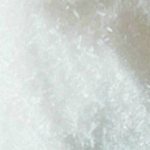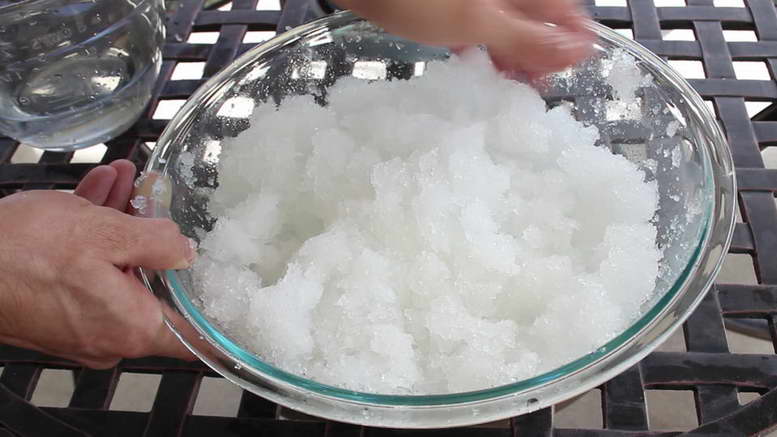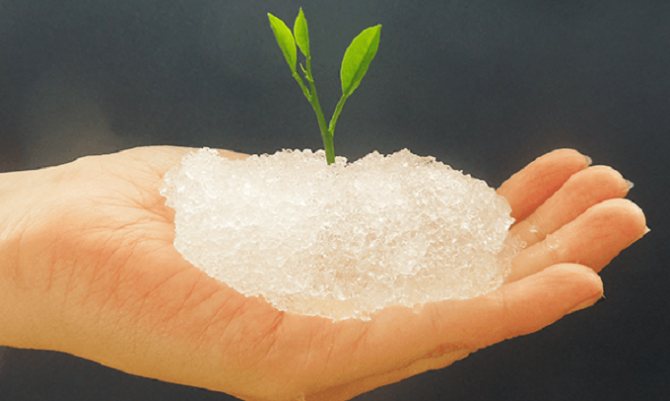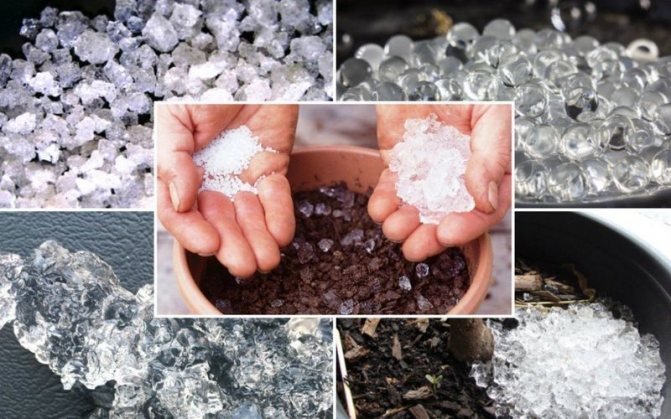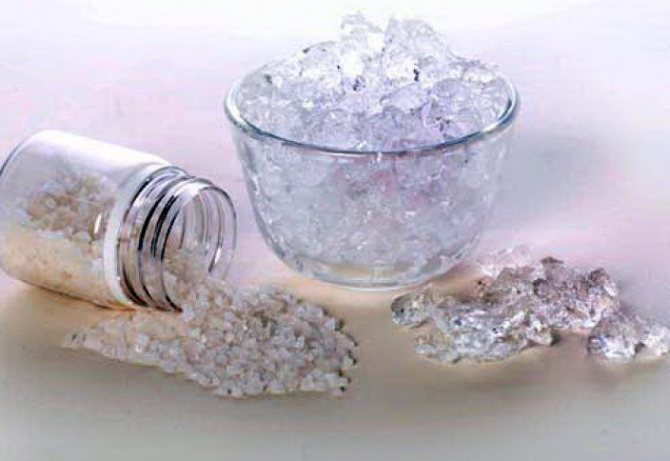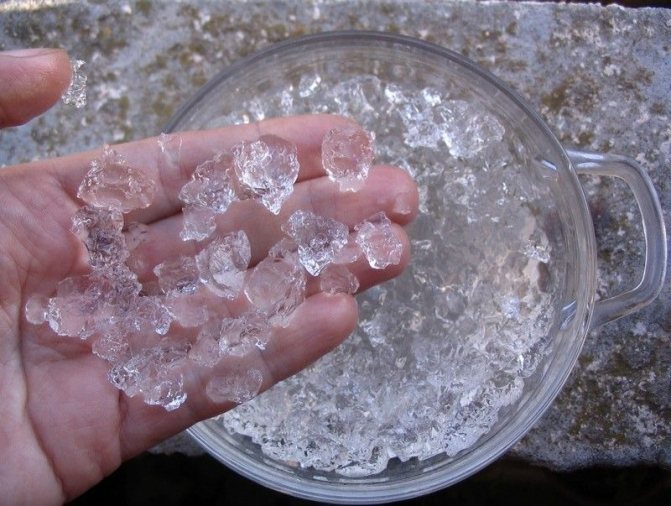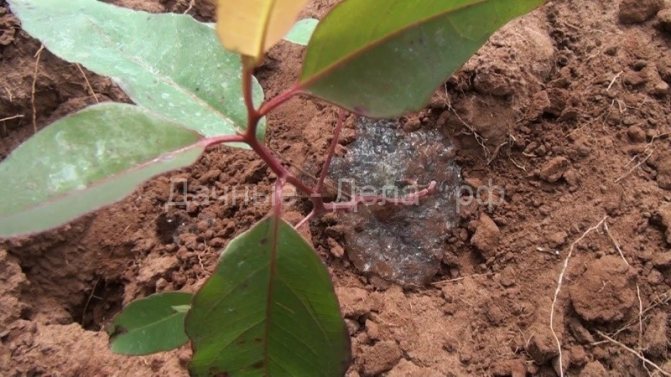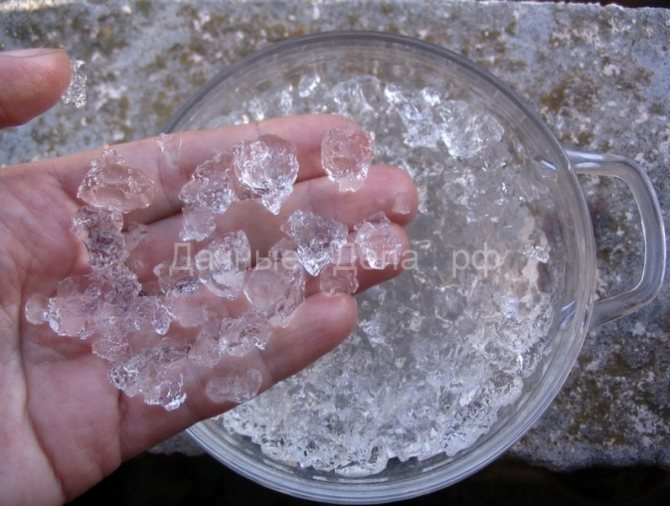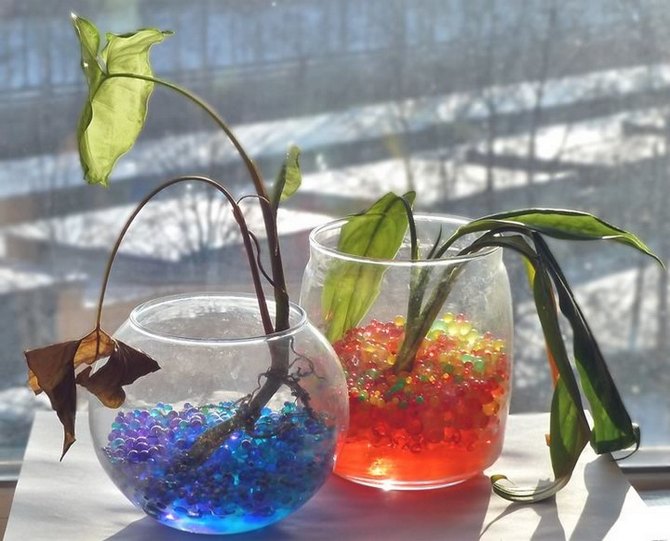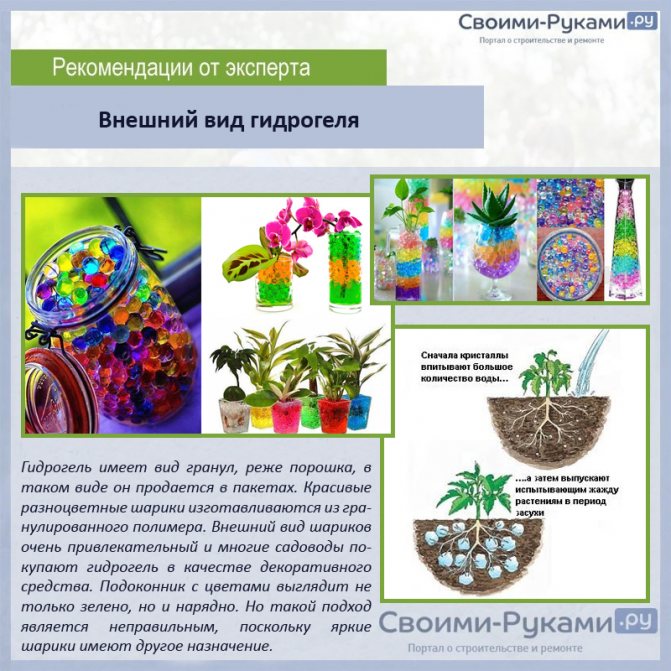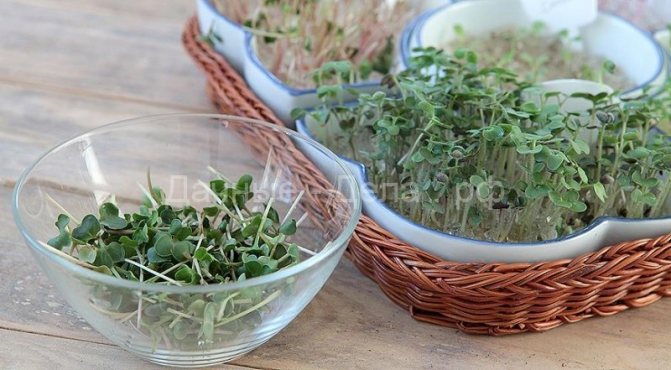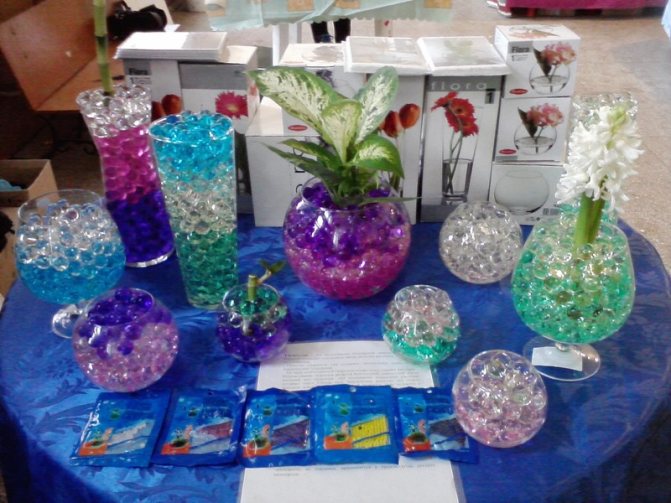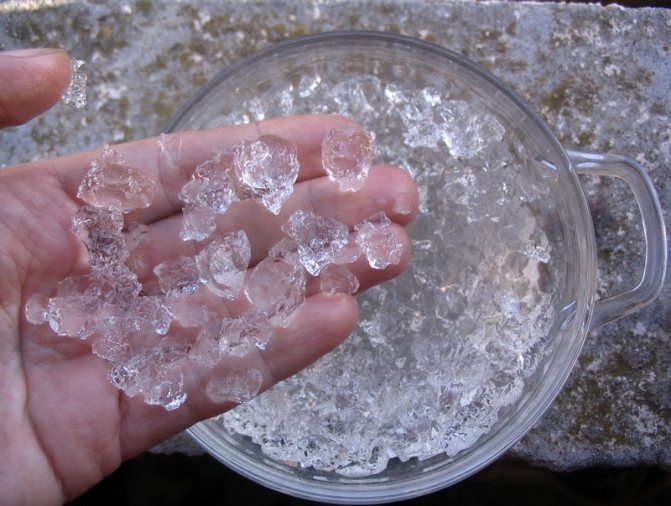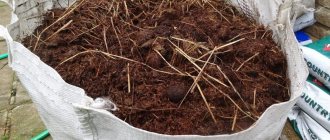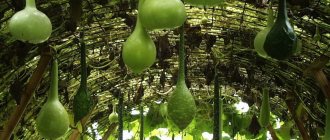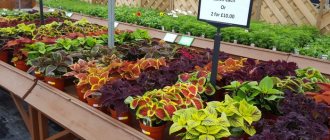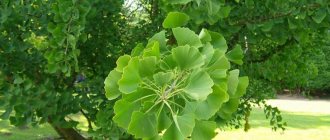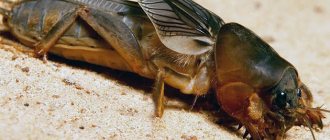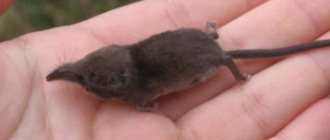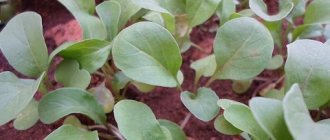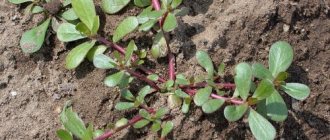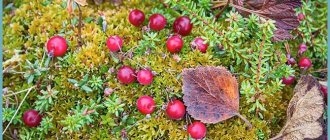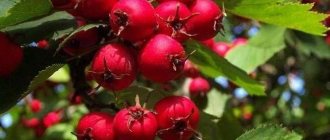The use of a hydrogel for plants is very convenient in cases where it is not possible to water them on time. The hydrogel is used not only for open ground plants, but also for any seedlings and in indoor floriculture. This material is used for additional moisture and feeding of crops. A special polymer allows you to gradually absorb water from it along with the fertilizer. The use of this material can significantly save not only time, but also water.
What is a hydrogel
Aqua primer or hydrogel is a moisture-absorbing polymer. It can be powdery, liquid and granular, transparent or colored. It is more often produced in the form of small balls. Upon contact with moisture (water, liquid fertilizer), aquagel absorbs it, swells and increases in size, becomes like jelly.

Application of avagrunt
One gram of hydrogel absorbs 200 - 300 ml of liquid. After swelling, the balls become a kind of reservoirs with water, from which moisture gradually evaporates or becomes a source of moisture for the soil and plant roots. The shelf life of the gel depends on its type and manufacturer, on average it is 5 years.
Polymer composition: carbon dioxide, water, ammonium and potassium salts. After the expiration date, they completely decompose and dissolve. These components are harmless to soil and plants. Aquaria are not "afraid" of drying, freezing and thawing. After the level of humidity and temperature is restored, the hydrogel for plants quickly regains its properties:
- retention of moisture and fertilizer solutions;
- prevention of cracking of the soil surface;
- moistening, improving the structure of the soil;
- acceleration of the period of flowering and fruiting of plants.
Types of hydrogel balls
Depending on the structure, appearance and purpose, there are 3 types of aquagel:
- Soft - colorless hydrogel. It is rarely used on its own, more often it is mixed with the ground. It is used for growing indoor flowers, rooting cuttings, germinating seeds, planting garden crops, horticultural crops. Plant roots easily penetrate the soft water granules and feed on moisture.
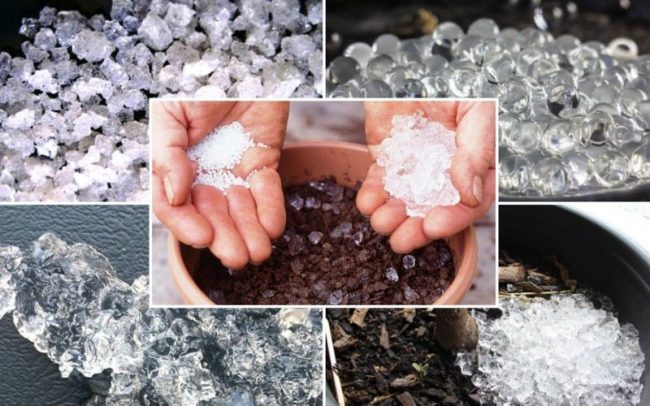

Soft - colorless hydrogel
- Dense (aqua soil) - decorative hydrogel. It comes in different shapes and colors, may contain sparkles, rhinestones. It is used as a filler for vases with natural flowers (instead of water), as well as for creating colorful compositions with indoor plants.
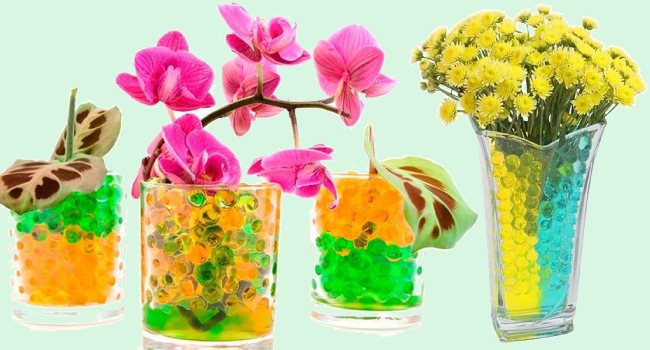

Hydrogel for flowers in a vase and pot
- Liquid - looks like soft gel balls for flowers. After contact with water, it does not swell, but dissolves in it. It is rarely used, mainly for soaking seeds. The polymer promotes their rapid germination, improves germination. Liquid hydrogel is not used for seed germination. It envelops them, blocks the access of oxygen to them.
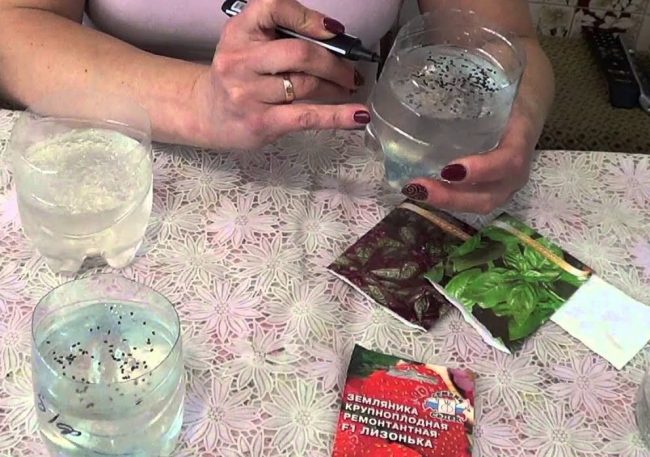

Hydrogel for soaking seeds
Hydrogel composition
They say everywhere that a hydrogel is made up of soft polymers.
Here is what a popular manufacturer, whose products can be trusted, writes about the composition of the substance:


Unfortunately, I did not find the detailed composition of the product, although I reviewed many packages.
Many people are concerned about the question: how to dispose of this substance? In fact, nothing.When the expiration date ends, the hydrogel breaks down into carbon dioxide, ammonium, potassium salts and water.
If you just don't need the gel anymore, throw it away with your household waste. For obvious reasons, it cannot be poured down the drain.
By the way! There is an opinion that when a substance decomposes, acrylamide is also formed - a dangerous substance that causes cancer (although you should not be afraid of it in panic - for example, it even forms in food when we fry it or bake it at temperatures above 180 degrees, so our bodies are fine familiar with this compound).
But still, personally, I throw away the old flower soil with hydrogel, out of harm's way.
Shelf life of the substance: from 2 to 5 years. For more accurate data, see the packaging of the product you purchased (the period may vary, since different manufacturers may differ in the formulas for the production of the hydrogel).
Growing plants in a hydrogel
According to the instructions, the hydro-primer can be used dry and soaked. Both forms of polymer are devoid of nutrients and cannot provide plants with conditions suitable for growth and development. For this reason, experts recommend not using them on their own, but mixing them with the ground. The ratio of the hydrogel to the soil is determined by several criteria: the quality of the soil, the conditions for planting and growing green spaces, the frequency of watering.
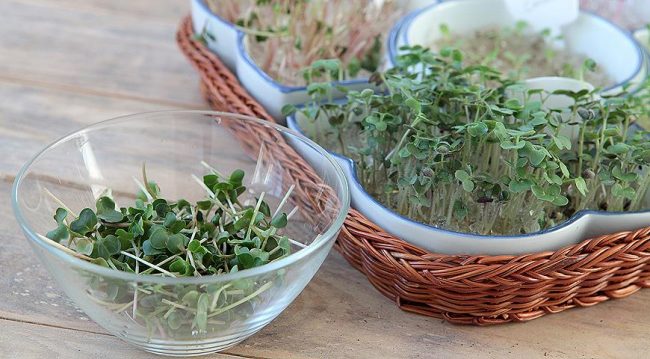

Salad grown in aqua soil
Recommended proportions: for dry polymer - 1 g / 1 l of soil, for soaked - 1 tbsp / 1 l of soil. Swollen granules are used for growing potted plants, dry ones for horticultural crops. It is not recommended to use hydroballs when planting drought-resistant flowers - orchids, cacti, succulents.
Germinating seeds
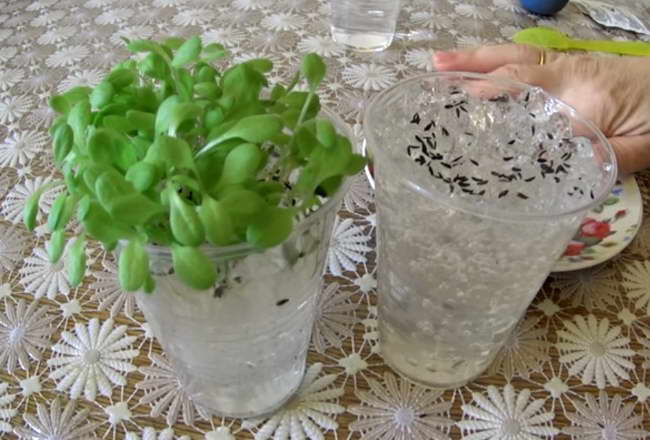

Seeds germinated in hydrogel
How to germinate seeds with a hydrogel:
- Fill the granules with water, leave to swell for an hour.
- Discard in a colander to remove excess liquid.
- Grind the swollen balls with a knife, blender, or grind through a sieve.
- Put the gelatinous mass on the bottom of a wide moisture-resistant container, the layer thickness is 3 - 5 cm.
- Spread the seeds on top, dip them a little into the gel with a match or a toothpick.
- Cover with foil, put in a warm place. Ventilate periodically.
- Moisturize the gel pad while reducing its volume by 30 - 50%.
- When the first leaves appear on the shoots, dive the shoots together with pieces of hydrogel into separate containers with soil.
Growing seedlings
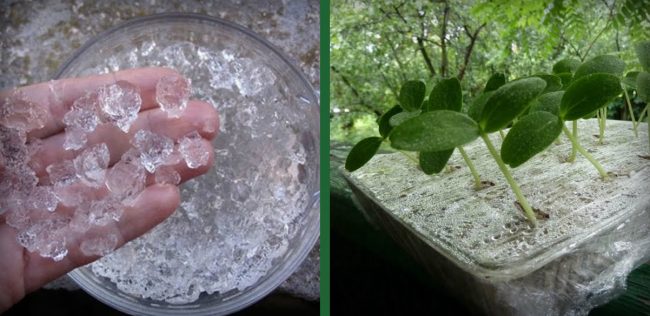

Growing seedlings with a hydrogel
There are two ways to use aquagel for growing seedlings:
- Mix polymer balls with soil, ratio 1: 4. Fill the container with the mixture, plant the seedlings. The method is good because it is easier to care for the seedlings: the number of waterings is reduced by 15 - 20%.
- On the bottom of the container without drainage holes, distribute the soaked aqua soil for flowers, the layer thickness is 1.5 cm. Fill the rest of the space with the prepared soil mixture, dive the seedlings into it. This method has two advantages: a reduction in watering, the development of not a superficial, but a deep root system of seedlings.
For indoor plants in pots
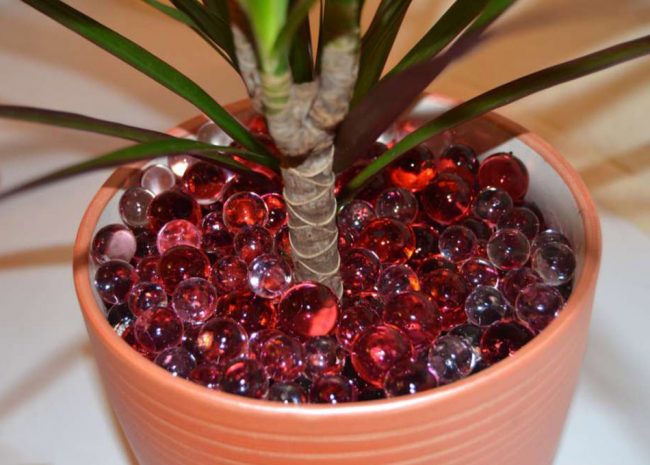

Applying a hydrogel for a flower in a pot
There are two ways to use the gel beads for growing potted plants: mixing with soil when planting a flower, or adding an already planted crop to the soil. How to use a hydrogel when planting indoor plants:
- Pour the water balls with settled water, leave to swell for an hour.
- Drain off excess liquid, mix granules with soil mixture. Proportions - 1 tbsp. aqua soil / 1 liter of earth.
- Fill the pot 2/3 full and place the flower on top. Spread the roots, add the remaining mixture, tamp a little.
How to add hydrogel beads to a pot with an already planted flower:
- With a simple pencil, make grooves in the soil, reaching the root system of the plant.
- Fill holes with dry gel granules, consumption 1 g / 1 L of earth.
- Water the flower.
- If, after swelling, increasing the volume, the balls break out to the soil surface, sprinkle them with earth by 1 - 2 cm.
- When the roots of the flowers grow through the gel (after 1 - 2 weeks), reduce the number of waterings by 5 - 6 times.
Hydrogel for flowers without primer


Using aqua soil
Ficuses, dracaena, chlorophytum, spathiphyllum, sheflera grow well in aquagel without soil. How to grow them correctly:
- Fill the granules with distilled or settled water, leave to swell for 1 - 3 hours. Drain off excess liquid.
- Rinse the flower's root system thoroughly.
- Pour 2/3 of the swollen gel balls on the bottom of transparent containers (glass vases, glasses), place the plant on top, straighten the roots, add the remaining hydrogel.
- Water the flower when the pellet volume has decreased by 30-50%. Use only settled or distilled water to prevent plaque and bacteria.
Varieties
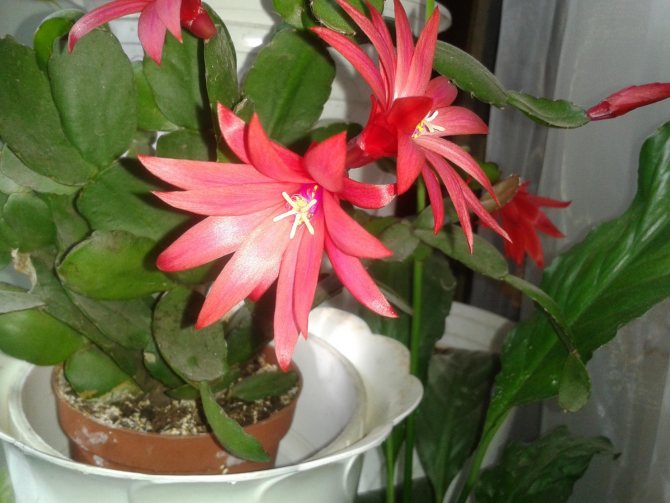

There are several types of hydrogels. All of them differ by density, composition and appearance. The main varieties include:
- Soft hydrogel. The use of this material allows you to moisten the roots, as well as loosen the soil. Such material has a jelly-like structure, therefore the roots can easily penetrate into the granules and absorb moisture. Soft granules make it possible to make the intervals between waterings as much as possible. During the absorption of moisture, the balls can grow 10-15 times, therefore, they can hold a large amount of water. 10 g of granules can absorb about 2 liters of water.
- Aqua primer is a dense hydrogel that is produced in the form of colored granules of various shapes. It can be in the form of balls, pyramids and cubes. The structure of such a material is much denser, therefore it absorbs moisture worse. Often these crystals are used as temporary ground or simply for decorative purposes. Such a hydrogel can be used many times, it is enough to rinse and dry it well. After 1-1.5 years, the decorative properties of this polymer decrease, and the ability to absorb water remains unchanged. The service life is about 5 years. After its completion, the material mixes with the soil, and after a few years it decomposes into ecological components. During decomposition, water, carbon dioxide and ammonium are formed. By itself, this polymer is non-toxic, so it does not cause any harm to plants.
Advantages and disadvantages of using
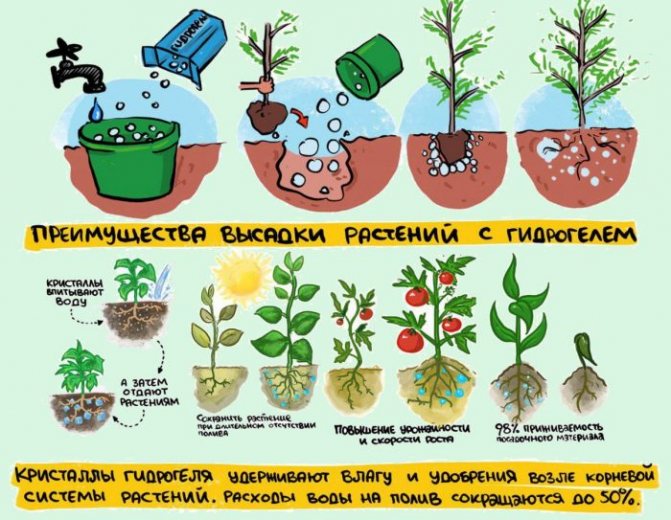

Pros of using aqua soil
Pros of hydrogel for plants:
- high water-holding properties;
- the ability to maintain the moisture content of the substrate for a long time;
- acceleration of the growth of seeds, planting material;
- preventing the leaching of nutrients and trace elements from the soil;
- supply of the root system, seeds with oxygen due to loosening of the soil;
- safety for plants, humans;
- the ability to store unused hydroballs in the refrigerator;
- prevention of moisture stagnation, root decay;
- reduction of crop irrigation;
- the possibility of using in open ground, greenhouses and at home;
- aesthetic appearance;
- ease of use.
Cons of hydrogel balls:
- the inability to use for growing seeds with a leathery shell (sweet peas, beans, beans) and plants with massive roots;
- the appearance of mold on the balls with prolonged exposure to sunlight;
- impossibility of reuse;
- lack of nutrients.
Purpose
Recently this material began to gain popularity. This is because it looks attractive and helps maintain moisture in the soil. The hydrogel is often made in the form of multicolored beads from a granular polymer.
Such material absorbs moisture well - 1 g can absorb about 200 g of liquid.Over time, the balls that have accumulated moisture begin to give it away, therefore the plants can be watered less often. On average, the moisture emitted by such granules is enough for 2-3 weeks. This is a great option for those who often go on business trips, and there is no one to water the flowers at home.
How well the roots absorb water depends on how well the root system is developed and how good the hydrogel is. After each watering, the balls collect a new amount of moisture. Due to the fact that such material retains moisture in itself, the roots of plants do not begin to rot from a large amount of water.
To make the hydrogel even more beneficial for the plant, you can water it not with ordinary water, but with an admixture of fertilizers. So, the granules will absorb liquid with useful microelements and gradually saturate the roots of the plant with them.
Design application
It cannot be categorically stated that an innovation in its pure form is no longer suitable for keeping flowers in it. However, the list of species that can survive in it is very short. House flower lovers have found that bamboo is a suitable plant hydrogel habitat. In natural conditions, he actually lives in water, so he survives in a hydrogel quite successfully. The rest of the flowers need soil, so putting them in a glass container, where only a beautiful colored hydrogel for plants is poured, means only delaying their death. For a while, your green friends will hold out on the water, but not too long. Yet this invention does not contain the necessary nutrition and does not stimulate the growth and development of plants. Even bamboo will have to be fed by dissolving the necessary fertilizers in water.
Questions and answers
What is the shelf life of a hydrogel after application to soil?
Depending on the microbiological composition of the soil, the hydrogel "lives" for 3-5 years. It freezes and thaws, tolerates drying without losing its qualities.
Can i store my swollen hydrogel?
It can be stored for 1-2 months in a dark place. The container is required sealed. If the container is without a lid, it will dry out, but after watering it will resume its shape.
How to regulate watering of plants in containers with hydrogel?
By drying the surface of the soil or even a deeper layer, it will not be possible to navigate. Because the hydrogel retains moisture and continues to saturate the roots of the flower. Therefore, the path is experimental. When the leaves lose their elasticity, water again. Don't feel like testing the plants? Try the timing scheme. So, if earlier the plant was watered every 2 days, then after the introduction of the hydrogel, it is permissible to increase the interval by 2 times.
Is the hydrogel able to increase the humidity of the air if it is decomposed on the soil surface?
It dries quickly outdoors and is not suitable as a humidifier. Sphagnum moss copes with this task perfectly, use it better.
Difference between hydrogel and aqua primer
Some poor-quality manufacturers began to produce aqua primer under the guise of a hydrogel. This material is more colorful and more attractive in appearance. Aqua soil is only a decorative element, so if used incorrectly, it can harm the plant.
There is also information that the aqua soil can be plant seeds... This is highly undesirable. As a result, there were a lot of negative reviews from buyers who fell for this marketing move and planted seeds directly in the aqua soil. It is recommended to use aqua primer together with a hydrogel.
Homemade nutrient polymer
You don't have to look for a polymer saturated with useful substances in the store, since it is not so difficult to make a hydrogel at home.To prepare a nourishing gel, you need water, garden hydrogel and humate. It is better to take a garden hydrogel with a fine fraction. The proportions are as follows:
- water - 1-1.2 liters;
- humate - 2 packs;
- garden gel - 10 g.
The cooking instructions are as follows:
- Take a 2 liter container and pour 1 liter of water into it.
- Pour humate into the water and mix.
- Introduce the hydrogel gradually, the process itself may resemble the preparation of semolina.
- Stir the mixture until it is smooth.
- Leave the resulting mass for 15-20 minutes.
If the mixture becomes very thick, then 200 g of water can be added to it. The resulting composition should not be liquid or very thick, the main thing is that it should be free of lumps.
How to use hydrogel for seedlings and germination
How to use hydrogel for seedlings, see the video:
For germinating seeds you should take soft hydrogel balls. They are also pre-saturated with water, to which it is better to add fertilizers. The benefits will be twofold, since the granules retain about 40% of the nutrients. By themselves, the balls do not contain either useful or harmful components. Water-soluble fertilizer, if added, will deposit in them and promote seed germination and sprout development.
Interestingly, the hydrogel was conceived and created for gardening, but in practice it has become popular in growing indoor plants.


Growing seedlings on a hydrogel photo
There are several ways of germinating seeds in a hydrogel. Start from the seed size and choose the method that works best for you. Can be sown in clean hydrogel saturated with water. In a swollen state, it increases significantly. It is crushed in a blender or grinded through a sieve.
Then the mass is placed in a container, making a layer about 3 cm thick, and the seeds are spread over the surface. If the granules are very large, they are simply cut in half. Seeds are closed by slightly pressing with a toothpick (with a strong deepening, oxygen access will be blocked). In both variants, cover the seed on top with foil and periodically lift to ventilate.
Growing seedlings with hydrogel and soil
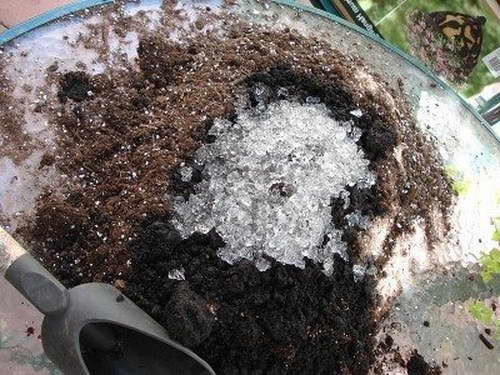

It is often practiced to germinate seeds in soil for growing seedlings together with a hydrogel. Take 3-4 parts of the soil mixture and 1 part of dry granules. First, the container is filled with a substrate, a uniform layer of swollen crushed hydrogel is poured on top. Seeds are sown in a hydrogel and sprayed with water; a film cover is also needed.
In both cases, at the stage of cotyledon leaves, the seedlings must be transferred into the soil together with a particle of the hydrogel so as not to damage the roots.
- Due to the unevenness of the surface, it is inconvenient to sow very small or dusty seeds on the hydrogel. Therefore, it must be mixed with the soil.
- Use a substrate for growing seedlings or a mixture of agrovermiculite and hydrogel, a more complex composition will do: hydrogel, agrovermiculite, perlite and sawdust in a 3/3/3/2 ratio. Mix the indicated components with the already swollen hydrogel so that the mass comes out loose.
- Use the gel with a fraction of 2-10 mm. If it is very small, you get the effect of a sticky porridge (wet hydrogel is slightly sticky).
- The container is also covered with foil and kept at a temperature of 24-26 ° C, ventilated.
- After the emergence of shoots, the shelter is removed and the temperature is lowered to a range of 23-24 ° C with a nighttime cooling of 4-5 degrees.
- After a couple of true leaves appear, plant the seedlings in separate containers with ordinary nutrient soil.
Growers are accustomed to sprouting seeds in the soil and are skeptical about the innovation. There is little experience with hydrogel and there are failures. With a favorable outcome, the seedlings are early and stronger, they tolerate transplantation well. Therefore, take a closer look at the innovation.It is important to always use a moisture-saturated hydrogel for seed germination.
Diaper hydrogel: how to use it for plants?
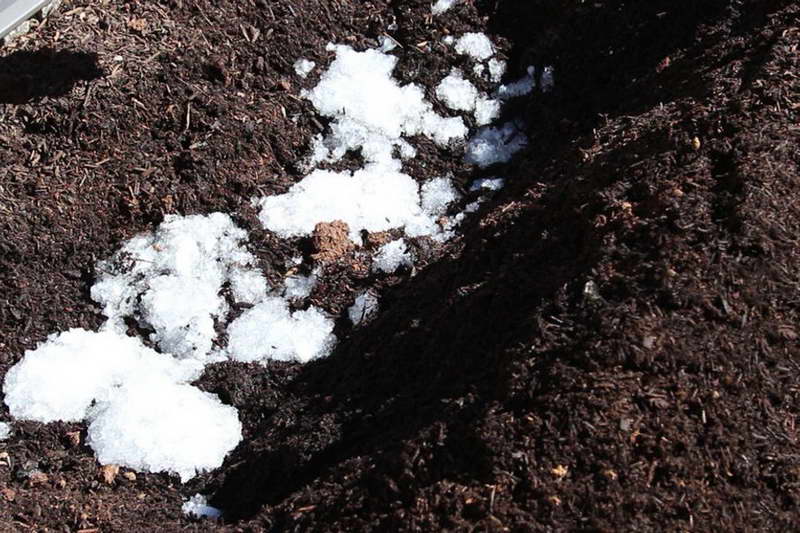

Diaper hydrogel use in the garden
It is biodegradable and environmentally friendly, so diaper hydrogel is a great option for working in your garden.
A diaper hydrogel will not only save you watering costs, but it will also last quite a few seasons before it needs to be replaced.
Used diapers must be opened, the hydrogel removed and used when planting plants, gradually adding to the planting holes or trenches.
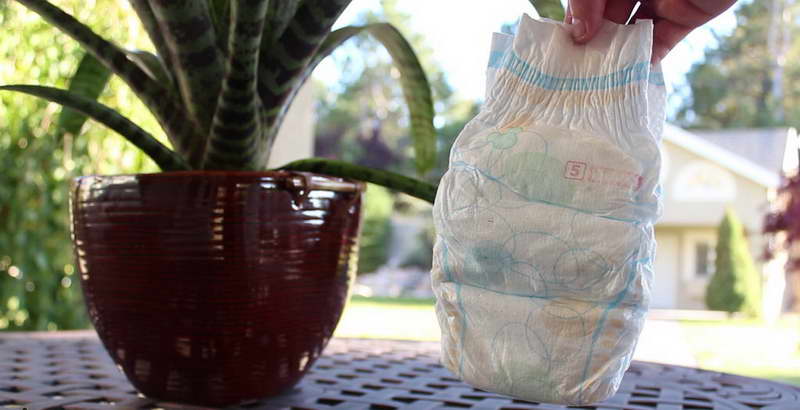

Diaper hydrogel for indoor flowers
This substance is also useful when planting indoor flowers: mix it with soil for indoor plants in a ratio of 1: 5 or put it on the bottom, filling it with soil on top, if the roots of the plant can penetrate deeply.

